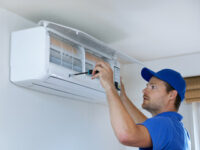The Basics of HVAC
HVAC is the heating, ventilation and air conditioning system that keeps buildings comfortable for their occupants. Learn the basics of hvac to better understand how it works, troubleshoot issues and make smart choices for your home.
Maintenance keeps equipment running efficiently and helps you avoid costly repairs or replacements. Preventive maintenance also helps you save on energy costs. Visit https://www.taphvac.com/ to learn more.
Whether you’re trying to avoid a cold shower on a frigid morning or stay warm and cozy while watching the snow fall outside, your home’s heating system plays an essential role in your daily life. HVAC systems vary in their size, configuration, and functionality, but they all share the same fundamental build concepts.
Understanding the basics of hvac helps you make smarter choices when choosing your next furnace. Learn about the key terms and acronyms associated with heating and cooling technology to help you navigate the lingo with ease.
Furnace efficiency — AFUE — measures how efficiently your furnace converts fuel into heat. A higher AFUE rating means greater energy savings.
Air quality — Your system can improve indoor air quality by filtering air to remove dust, allergens, bacteria, and other debris. It can also control humidity if it has a dehumidifier or humidifier built in.
Duct size — Your HVAC system needs enough duct space to circulate air throughout your home. Generally, larger homes require bigger ducts to ensure adequate airflow.
Thermostat settings — Your thermostat controls the temperature in your home and determines how much energy your system uses. Setting the thermostat at a lower temperature during the day and raising it before you go to sleep will save energy, while keeping your home comfortable.
Ventilation — Your home’s ventilation system moves fresh air in and out to keep it circulating. It’s important to regularly check your vents and clean them of any obstructions to ensure proper airflow.
Cooling — Your HVAC system can also function as an air conditioner during the summer by removing excess heat from your home and expelling it outdoors. To do this, the system draws air in and forces it over the evaporator coil. The evaporator coil absorbs heat and turns liquid into water vapor, which is then drawn away through the condenser coil and expelled outside.
With so many options available for heating, cooling, and ventilation in homes today, it’s important to do your research and understand what each type of system offers. By doing so, you’ll have the knowledge to choose a system that best meets your home’s unique requirements.
Cooling
When it’s a hot summer day, you appreciate the blast of cool air that flows into your home thanks to your HVAC system. It’s one of the cornerstones of modern indoor living, regulating temperature and air quality while removing stale, contaminated air.
HVAC systems have many moving parts, a number of which can fail over time. It’s crucial to work with licensed, certified professionals who have the experience to install and repair equipment efficiently and safely. And Services technicians are trained to evaluate your home, recommend the right system based on square footage and budget and properly size each piece of equipment to avoid overworking it.
Most people are familiar with the three primary elements of an HVAC system: heating units, ventilation ducts and air conditioning. When these components work together, they create comfortable indoor environments and maintain a healthy level of humidity.
Heating units such as furnaces or boilers generate heat to raise indoor temperatures during the winter, making the space livable in cold weather. Ventilation ducts keep the air fresh by circulating it throughout the building, preventing stagnant odors and reducing the risk of mold or mildew. And cooling units use refrigerant to draw heat out of the air and expel it outdoors, thereby cooling the interior spaces.
The best way to choose a heating and cooling system is to find one with an energy efficiency rating of at least 13 or 14. To determine an efficient rating, look for the SEER rating, which stands for Seasonal Energy Efficiency Ratio. SEER ratings are given to equipment that meets specific performance standards set by the Air Conditioning, Heating and Refrigeration Institute.
If you’re interested in working with HVAC systems, a career in this field offers many rewarding opportunities. From certificate programs to associate degrees, you can hone your skills in the lab and in the field while learning about everything from advanced equipment design to EPA certification requirements for handling refrigerants. You can even find programs that offer paid internships and hands-on training with leading manufacturers. When you’re ready to start your career, a high school diploma or GED certificate is the minimum requirement for most entry-level positions.
Ventilation
Ventilation is an essential part of any HVAC system, and is the process through which fresh air is introduced into a home or building while stale air is removed. This can be accomplished through natural or mechanical means.
Ventilating your home can reduce indoor pollutants and improve overall health. These contaminants include dust mites, pet dander, pollen, bacteria, cigarette smoke and carbon dioxide. Many of these are irritants and can lead to allergies, dizziness and upper respiratory problems. Ventilation can also help with moisture, which can cause mold and bacterial growth.
In an HVAC system, ventilation occurs when air is drawn into a duct from outside and then passed through a heat exchanger. The heat exchanger reduces air temperature by cooling it through convection, radiation or conduction. The cooled air is then distributed throughout the house by fans. The blower assembly is another important component of your HVAC system. It draws in the air, cools it and passes it through a filter before blowing it out through return ducts into your home. This creates positive air pressure and can be manipulated by adjusting your return vents.
When it comes to a residential system, there are two types of vents – supply and return. The small vents found in your home are the supply vents, which allow you to warm or cool air as needed. The larger vents that contain your air filters are the return vents, which pull air back into your system. It’s a good idea to clean and replace air filters frequently to help prevent buildup.
Whether you’re thinking about getting into the field, want to improve your home or just have a general interest in how your systems work, having an understanding of the world of HVAC is empowering. The knowledge you gain will help to ensure comfort, safety and energy efficiency for you and your family. Our team is here to help with any questions or concerns that you may have. Contact us today to learn more about how we can serve you!
Controls
You depend on your HVAC system to keep you comfortable in winter and summer, but how does it work? It all starts with the controls.
An HVAC control system is a set of electronic devices that monitor and manipulate the equipment in order to maintain environmental conditions like temperature, air pressure, and humidity. These systems can be simple standalone pieces of equipment that use an on/off switch, or they can be part of a larger Building Management System (BMS) that uses a frontend computer to control all the different components in the facility.
In newer facilities, the majority of controls are digitally based and communicate via a technology known as Direct Digital Controls or DDC. These control circuits are more reliable than their pneumatic counterparts, which run on air pressure and use mechanical means to perform control functions. While it is possible to retrofit a building with pneumatic controls, DDC offers a number of advantages that make it the preferred control system for most new construction and remodeling projects.
The heart of the HVAC control system is the unit controller. This is a small computer that is loaded with factory-installed routines to control a specific piece of equipment. The unit controllers are connected to each other using a network of sensors and wires.
A sequence of operations is used to automate the activities of the HVAC systems based on input data from sensors and simultaneous actions of other equipment. For example, if a sensor senses that the room is too cold, the control system may send an analog output signal to open a 2-way valve and increase the flow of hot or cold air into the room. The unit controller will then follow the logic to change the temperature in the room back to the desired setting based on preprogrammed routines.
The unit controllers are also loaded with time schedules, alarms, trend logs, and other data for monitoring and controlling the HVAC system. This is important because the BMS must be able to adjust for environmental changes, such as changing weather conditions or increasing occupancy in the building.






